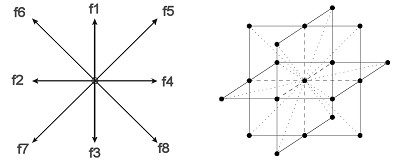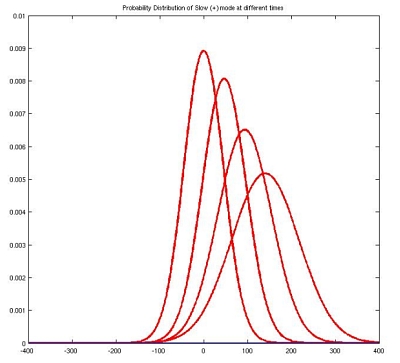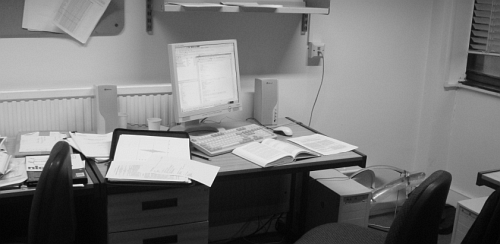Denis Lapitski
Lattice Boltzmann Simulation of Quantum Systems
In my research I work on application of the Lattice Boltzmann Method (LBM) to the simulation of Quantum Systems. The LBM has been developed fairly recently for the purposes of fluid simulation as an improvement of the Lattice Gas Celluar Automata. It is based on the molecular interactions as governed by Statistical Mechanics, and the Boltzmann equation in particular. The method discretizes the position and velocity phase space occupied by the fluid and simulates the movement and collision of virtual particles at discrete, periodic moments in time. It is now widely used in both academia and commerical applications, such as simulation of turbulent flow of air around a car or plane, or the simulation of hot water and air in making of coffee in an espresso machine.
For example, a two-dimensional space can be divided into square subsections. Then a simulated particle can occupy only the intersections of our square grid, no particles can be located between the gridpoints, and no more than one particle can be found at a single grid intersection at a given discrete time. Moreover, the particle can have one of a finite number of velocities which will take it to one of the nearby grid intersections during the next timestep, or zero velocity, which causes the particle to remain in the same position. An example of such a lattice can be seen in the figure below, with nine discrete velocities f1-f9 (f9 = 0). It is classified as a D2Q9 Lattice, and the three-dimensional discretization on the right is a D3Q19 lattice.

The time scale is also discretized given a particular timestep - the difference between two adjacent time values. The simulation is then run in two steps for each timestep: particle streaming according to the velocity of each particle and particle collisions when the velocities bring two particles to the same lattice point. The resulting effect will display the behaviour of a fluid flow, and approach the solution of the Navier-Stokes equations. Better simulation is achieved by reducing the timestep, increasing the number of simulated particles and making the lattice grid finer. However computation time grows as the simulation becomes more detailed and a balance must be found. An example of fluid flow past obstacles computed using the Lattice Boltzmann method can be seen below.
The general formulation of the LBM is the following equation with the streaming term on the left-hand side and the Bhatnagher-Gross-Krook collision operator on the right-hand side, which calculates the relaxation to equilibrium.

The actual quantities computed are not individual particle positions but probability distribution functions (f). Each discrete velocity in the simulation has a probability function which designates a distribution of particles with that velocity vector over the whole space.
More recently it has been suggested that LBM can be also used to simulate the behaviour of quantum particles, such as electrons, photons and more exotic types. Compared to classical ball-like molecules of macroscopic fluids, the wavefunctions of quantum particles do not have a definite position and interact with each other in more complicated ways than elastic collisions. One such approach has been developed by Sauro Succi. He draws parallels between the Lattice Boltzmann equation and the Dirac equation, which governs the relativistic behaviour of quantum particles. The Majorana form of the one-dimensional Dirac equation,

can be discretized to produce the following Quantum Lattice Boltzmann scheme.

Because in the non-relativistic limit we can obtain the Schrodinger equation from the Dirac equation (in a similar way we can derive the Navier-Stokes equations from the Lattice Boltzmann equation), the QLB can simulate the behaviour of a wave function under the Schrodinger equation. Below you can see a plot of the evolution of the the wave function probability density computed using Succi's QLB. The wave packet, given an initial velocity to the right, moves and disperses with each timestep as it is governed to do under the Schrodinger equation.

This QLB method can still be improved and expanded to simulate other quantum systems. That is the goal of my current research.

